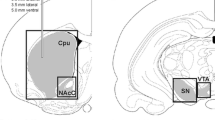Studies of changes in the numbers and some morphometric parameters of neurons and gliocytes in the mesoaccumbocingulate (MAC) dopaminergic system in rats were performed using pre- and postnatal exposure of this system to opiates, i.e., 0.1 mg as 1% morphine hydrochloride solution into the amnion of fetuses of female Wistar rats (n = 4) on post-fertilization day 17 or i.p. to rat pups on postnatal day 4 (n = 4). Perinatal exposure to morphine induced chromophilic degeneration, swelling, and the death of some neurons, along with decreases in the volumes of other (less damaged) neurons in the MAC system of rats. Neuron damage, more marked after prenatal administration, was accompanied by an increase in the number of microgliocytes and their phagocytic activity. Morphine did not alter the number of satellite macrogliocytes or the mean distance from these cells to the bodies of less damaged neurons.
Similar content being viewed by others
References
R. V. Berezhnoi, Ya. S. Smusin, and V. V. Tomlin, Handbook on Forensic Medical Assessment of Poisoning [in Russian], Meditsina, Moscow (1980).
D. V. Bogomolov, Yu. I. Pigolkin, and O. V. Dolzhanskii, “Morphometric studies of neuroglial complexes in the brain in forensic medical diagnosis of drug addition,” Sud.-Med. Ekspert., 44, No. 4, 18–19 (2001).
O. V. Dolzhanskii, Forensic Medical Assessment of Morphological Changes in the Brain in Chronic Opioid Addiction, [in Russian], Author’s Abstract of Master’s Thesis in Medical Sciences, Moscow (2001).
A. Bjorklund and O. Lindvall, “Dopamine-containing systems in the CNS,” in: Handbook of Neuroanatomy, Vol. 2, Classical Neurotransmitters in the CNS, Elsevier Science Publishers, Amsterdam, New York (1984), pp. 55–122.
P. E. Knapp and K. F. Hauser, “mu-Opioid receptor activation reduces DNA synthesis in immature oligodendrocytes,” Brain Res., 16, No. 1–2, 341–345 (1996).
D. Sonetti, E. Ottaviani, and G. B. Stefano, “Opiate signaling regulates microglia activities in the invertebrate nervous system,” Gen. Pharmacol., 29, No. 1, 39–47 (1997).
E. Tanaka and R. A. North, “Opioid actions on rat anterior cingulate cortex neurons in vitro,” J. Neurosci., 14, No. 3, 1106–1113 (1994).
Author information
Authors and Affiliations
Additional information
Translated from Morfologiya, Vol. 136, No. 6, pp. 35–37, November–December, 2009.
Rights and permissions
About this article
Cite this article
Droblenkov, A.V., Karelina, N.R. & Shabanov, P.D. Changes in Neurons and Gliocytes in the Mesoaccumbocingulate System on Perinatal Exposure to Morphine in Rats. Neurosci Behav Physi 40, 848–851 (2010). https://doi.org/10.1007/s11055-010-9334-0
Received:
Published:
Issue Date:
DOI: https://doi.org/10.1007/s11055-010-9334-0




